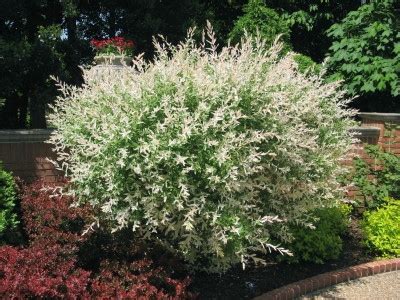Riverdene Garden Center
Hakura Nishiki Tricolor Willow
Hakura Nishiki Tricolor Willow
Couldn't load pickup availability
Salix integra ‘Hakuro Nishiki’
Hakuro Nishiki, also known as Dappled Willow or Tricolor Willow, is a fast-growing, compact deciduous shrub or small tree prized for its stunning pink, white, and green variegated foliage. New growth emerges pink, then transitions to white and green, creating a beautiful dappled effect. This cold-hardy (Zone 4-7), adaptable, and low-maintenance shrub is ideal for borders, hedges, specimen plantings, and containers in Southwest Saskatchewan.
Planting & Location
- Hardiness Zone: 4-7 (borderline hardy in Zone 3 with winter protection)
-
Mature Size:
- Shrub form: 4-6 feet tall, 4-6 feet wide
- Tree form (if grafted): 8-10 feet tall, 5-6 feet wide
- Growth Rate: Fast (up to 2-3 feet per year)
- Sunlight Needs: Full sun to partial shade (best color in 6+ hours of sun)
-
Soil Preference:
- Prefers moist, well-drained loamy soil.
- Tolerates clay, sandy, and slightly acidic to alkaline soils.
- Avoid dry, compacted, or overly wet soils.
- Spacing: 4-6 feet apart for mass planting, 6+ feet apart for individual shrubs.
Watering
- Young Plants (First Year): Water deeply 1-2 times per week to establish roots.
- Established Shrubs: Prefers consistent moisture, water once per week in dry conditions.
- Avoid Overwatering: Prefers moderate soil moisture, but never let soil fully dry out.
Fertilizing
- First Year: No fertilizer needed—focus on root establishment.
-
Mature Shrubs:
- Apply a balanced slow-release fertilizer (e.g., 10-10-10) in early spring to encourage strong growth and vibrant foliage.
- Organic alternative: Compost or well-rotted manure in spring.
Pruning & Maintenance
- Best Time to Prune: Late winter to early spring, before new growth starts.
-
How to Prune:
- Remove dead, damaged, or weak branches to encourage fresh, healthy growth.
- Hard prune (cut back to 12 inches above ground) in early spring to encourage the best pink and white variegation.
- Light shaping can be done throughout the growing season.
Flowers & Foliage
- Bloom Time: Early spring (April-May) (not grown for flowers, but produces small catkins)
- Flower Type: Yellow catkins (insignificant)
-
Foliage:
- Spring: Pink new growth
- Summer: White, green, and pink dappled leaves
- Fall: Golden-yellow foliage before dropping
Pest & Disease Management
Resistant to: Deer, urban pollution, and most pests
Common Pests:
-
Aphids – May cause curled leaves and sticky honeydew.
- Solution: Spray with insecticidal soap or introduce ladybugs.
-
Spider Mites – Can cause leaf discoloration in hot, dry conditions.
- Solution: Hose off with water or use insecticidal soap.
Common Diseases:
-
Powdery Mildew – White fungal coating on leaves.
- Solution: Improve airflow and apply fungicide if needed.
-
Leaf Spot (Fungal or Bacterial) – Causes brown spots on foliage.
- Solution: Avoid overhead watering and remove infected leaves.
Winter Protection
- Hardy in Zone 4, but in Zone 3 areas, apply a thick layer of mulch (2-4 inches) to insulate roots.
- Young plants may benefit from burlap wrapping in exposed areas during harsh winters.
- Rodents & Deer: Generally resistant, but young plants may need protection.
Landscape Uses
Great for specimen planting, hedges, and borders
Beautiful, multi-season foliage interest
Can be shaped into a small tree or kept as a shrub
Fast-growing and adaptable to various conditions
Attracts pollinators and provides light shade
Additional Notes:
- Hakuro Nishiki is one of the most colorful ornamental willows, prized for its vibrant pink and white foliage and elegant form.
- Lifespan: 20+ years with proper care.
- Works well in rain gardens, cottage gardens, modern landscapes, or as a focal plant.
Photo courtesy of NC State University
Share


